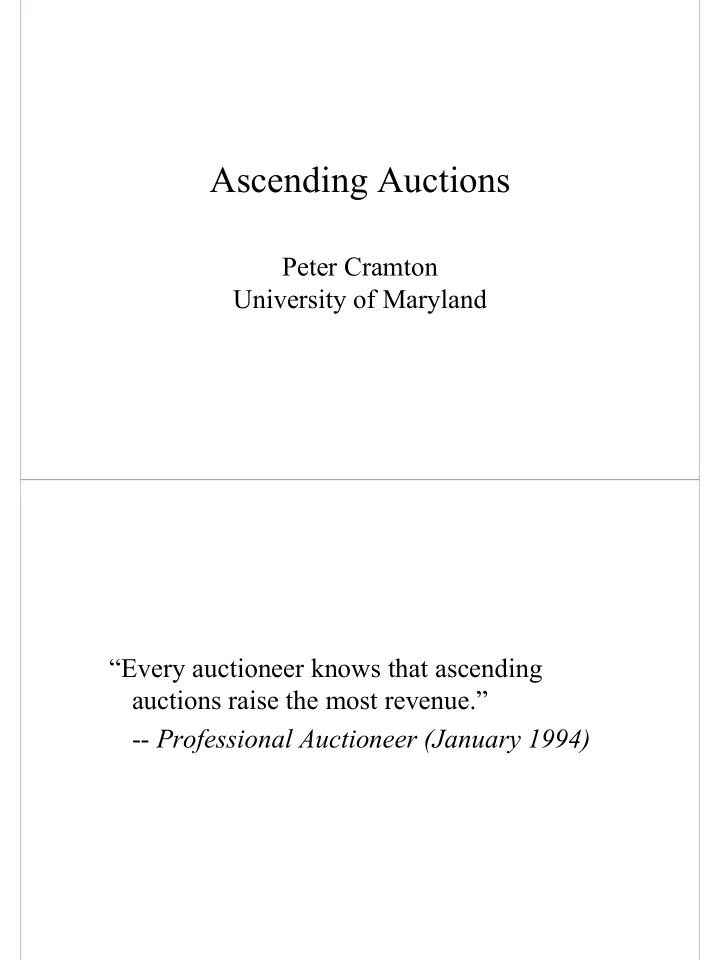

Ascending Auctions Peter Cramton University of Maryland “Every auctioneer knows that ascending auctions raise the most revenue.” -- Professional Auctioneer (January 1994)
Examples • Ascending auction: FCC spectrum auctions – most exceed industry revenue estimates – C-block business plans initially at $20/person; auction ends at $40/person • Sealed-bid auction: Brazil cellular auction – BellSouth high bid at $2.5 billion ($139/person) – AT&T second highest at $1.5 billion Why ascending bid? “Who should get items and at what prices?” • Price discovery process – Open and transparent (legitimate) – Reliable market prices (learning) – Efficiency • Single item: quite general; strategically simple • Many items: arbitrage and packaging possible
Why ascending bid? • Revenue maximization – Efficient auctions raise a lot of revenue • May be optimal to award to those with highest values • Devices to increase revenues often impractical – Reserve prices and handicaps • Efficiency looks even better in general model – Endogenous participation – Resale Revenue maximization • Reduces winner’s curse – Milgrom & Weber (1982) • Others willing to pay nearly as much • Not raising is a confession of inferiority “If its worth $x to them, why isn’t it worth that much to us? Aren’t we a good company?” • Budget constraints can be relaxed
Why ascending bid? • Privacy – Don’t reveal upper part of demand curve • Implementation – Less vulnerable to corruption (don’t need secrecy) – Avoid commitment problem (don’t have to reject later bids) Why sealed bid? • Implementation – Don’t have to bring parties together – Simple – Difficult bid evaluation OK • Procurement: Quality of job important
Why sealed bid? • Ex ante asymmetries – If know high valuer wins, then no incentive to bid – Almost common value (Klemperer 1997) • Ascending bid may lead to low revenues because bids are strategic substitutes – Typically not possible to level playing field • Price preferences in government procurement Why sealed bid? • Risk aversion – First-price better in IPV (Maskin & Riley 1985) – But not true with affiliated values • Aggressive bidding risky due to winner’s curse – Not true if bidder is agent • Leaving money on the table is risky
Why sealed bid? • Avoid collusion – Can’t punish deviations in current auction – But can punish outside or in another auction – Sealed bid not immune from collusion – Dynamic process of ascending auction can be used to identify and enforce collusive outcome • Zero-price equilibria • Can be designed to minimize problem Ascending auction for multiple items • Identical items – Demand schedules in each round – Activity rule (Wilson 1997) • Can’t increase quantity • Must improve a losing bid or bid is rejected • Based on revealed preference
Sample Demand Curve P S winning bids p* clearing price D losing bids Q Identical items • Demand schedules – Pricing rules • Uniform pricing • Pay-your-bid pricing – Can coordinate on low revenue equilibrium under uniform pricing • Wilson (1979) and Back & Zender (1993)
Identical items • Ascending clock – Clock indicates prices – Bidder selects quantity – Can’t increase quantity as price rises – Get uniform price without coordination on low revenue equilibrium – But inefficient (Ausubel & Cramton 1996) Identical items • Ausubel (1997) efficient ascending auction – Ascending clock, but items awarded when “clinched” at the clinched price – Item clinched when it becomes mathematically impossible to lose item (excess demand would drop to zero before you could drop demand to zero) – Get efficiency and benefits of ascending bid
Interdependent items • FCC spectrum auctions – some substitutes; some compliments • Simultaneous ascending auction – All items on block at same time – Can bid on any items – Auction ends when no bids on any item Simultaneous ascending auction • Advantages – Reduces uncertainty (winner’s curse) – Can react to prices in setting bids across items • Similar items sell for similar prices • Efficient packaging • Disadvantage – May “negotiate” a split of items at low prices – But can eliminate undesirable bid signaling
Conclusion • Ascending bid typically better than sealed bid on both efficiency and revenue grounds • Concerns – May allow bidders to identify and enforce low revenue equilibrium – May do worse if weak competition or ex ante asymmetries
Recommend
More recommend